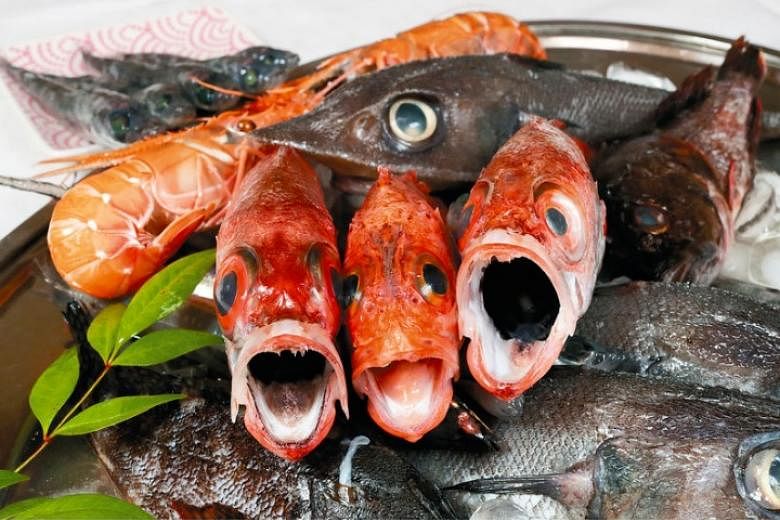THE JAPAN NEWS/ASIA NEWS NETWORK - NUMAZU (Shizuoka) - Almost no place on Earth remains unexplored; the empty spaces on the map have been filled in. But what if we examine the sea?
I recently went to Heda Port, about an hour by car from the central part of Numazu, Shizuoka prefecture. When I saw the strange creatures that had been landed in the port, I smiled inwardly, thinking: "There is an unknown world."
They have eyes that are too big, sharp noses and underbites that flash sharp teeth. They looked strange, but somewhat lovable too. These were fish from the deep sea.
Suruga Bay is the deepest bay in Japan, with a depth of up to 2,500m. The deep sea spreads under an area that is about 20 minutes by ship from the port.
"This is Japanese grenadier, called geho in the region and commonly known as tojin. You can enjoy it raw. And these are Japanese codling and twinkle-eyed fish (chlorophthalmus borealis)." said Mr Toshiyuki Nakajma, the 64-year-old owner of the restaurant Marukichi in front of the port.
Heda Port is a landing port for Takaashigani spider crab, which live 200 to 600m deep in the ocean. Many deep-sea fish are also caught in trawling nets. Mr Nakajima, who took over his wife's parents' restaurant, was interested in those fish, most of which were cast aside by fishermen. He learnt about the fish through picture books, cooked them and ate them.
"I found they were delicious," Mr Nakajima recalled. They can be eaten raw, and it's also good to simmer or deep-fry them. Hoping to inform many people of their good flavour, he added deep-sea fish dishes to the menu about 10 years ago.
"They look grotesque, but it's so they can survive in harsh conditions," said Mr Naoki Tanaka, 47, a member of the comic duo Cocorico. They have big eyes to detect small amounts of light, and fierce mouths so they can catch scarce prey effectively.
Mr Tanaka likes living things so much that he took on the post of honorary director of the Suruga Bay Deep Sea Creatures Museum in the Heda district. "There are many unknown things about them, and that's why deep-sea fish are interesting," he said.
Ryo Fukase, a 29-year-old chef who worked at a restaurant in Tokyo to learn cooking and other skills, is also attracted to deep-sea fish. He opened the restaurant Yoshoku (Western food) Kitchen Fukacche last summer, and offers French dishes incorporating deep-sea fish by advance reservation. The menu includes braised rosy seabass, Japanese lobster risotto and bouillabaisse.
Various landscapes
Deep-sea fish have also been a boon to the central area of Numazu.
"I wanted to create a one-of-a-kind facility that local people can be proud of," said Mr Shinichiro Sato, 41, a senior official of the more than 100-year-old company Samasa Suisan Co. The result of his passion is the Numazu Deepblue Aquarium, which opened in 2011 at Numazu Port.
Mr Sato's grandfather developed a purchase channel from the Kyushu region and made Numazu the nation's largest production place for dried aji horse mackerel. However, the industry began shrinking at the beginning of the Heisei era, which started in 1989. Tourists were stopping in the city only for lunch.
In this situation, Mr Sato focused on deep-sea fish. In addition to mendako octopuses caught in Suruga Bay, the aquarium exhibits more than 60 kinds of deep-sea creatures from around the world. It also exhibits frozen and taxidermied coelacanths, which are called "living fossils" because their form has remained unchanged for 350 million years.
Areas around the aquarium were developed as the Minato 83 Banchi restaurant district, which is home to restaurants offering deep-sea fish dishes such as kaisendon samasa. The aquarium attracts 400,000 visitors a year, and the number of tourists visiting the port and surrounding areas has increased by 700,000 to over 1.7 million in the six years since the opening of the aquarium.
People can also enjoy stunning views in Numazu. The largest height difference between the summit of Mount Fuji and the bottom of Suruga Bay is over 6,000m. You can enjoy cruising in the bay and driving along the sea to the Heda district. You will see various types of scenery, such as mikan fields in Nishiura and Cape Osezaki jutting out into the sea, along with Mount Fuji over Suruga Bay.
From Cape Deai Misaki, I saw Heda Port below, a quiet, natural spot embraced by the curved Cape Mihama. The evening view was breathtaking.
Access
It takes about 50 minutes by shinkansen from Tokyo Station to Mishima Station, and about six minutes from there by the Tokaido Line to Numazu. To the Heda district, it takes about 90 minutes by route bus or share-ride taxi service (reservation required).
For more information, call the Numazu municipal government's tourism strategy division on (055) 934-4747.

